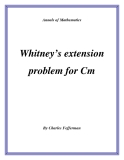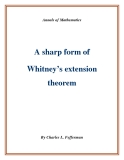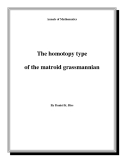
Whitney’s extension
-
Let f be a real-valued function on a compact set in Rn , and let m be a positive integer. We show how to decide whether f extends to a Cm function on Rn . Introduction Continuing from [F2], we answer the following question (“Whitney’s extension problem”; see [hW2]). Question 1. Let ϕ be a real-valued function defined on a compact subset E of Rn . How can we tell whether there exists F ∈ C m (Rn ) with F = ϕ on E? Here, m ≥ 1 is given, and C m (Rn ) denotes the space...
 48p
48p  noel_noel
noel_noel
 17-01-2013
17-01-2013
 39
39
 8
8
 Download
Download
-
In this paper, we solve the following extension problem. Problem 1. Suppose we are given a function f : E → R, where E is a given subset of Rn. How can we decide whether f extends to a Cm−1,1 function F on Rn ? Here, m ≥ 1 is given. As usual, Cm−1,1 denotes the space of functions whose (m − 1)rst derivatives are Lipschitz 1. We make no assumption on the set E or the function f. This problem, with Cm in place of Cm−1,1, goes back to Whitney [15], [16], [17]. To answer it, we prove the following sharp form of the Whitney extension theorem....
 70p
70p  noel_noel
noel_noel
 17-01-2013
17-01-2013
 62
62
 6
6
 Download
Download
-
Characteristic cohomology classes, defined in modulo 2 coefficients by Stiefel [26] and Whitney [28] and with integral coefficients by Pontrjagin [24], make up the primary source of first-order invariants of smooth manifolds. When their utility was first recognized, it became an obvious goal to study the ways in which they admitted extensions to other categories, such as the categories of topological or PL manifolds; perhaps a clean description of characteristic classes for simplicial complexes could even give useful computational techniques.
 25p
25p  tuanloccuoi
tuanloccuoi
 04-01-2013
04-01-2013
 64
64
 7
7
 Download
Download
CHỦ ĐỀ BẠN MUỐN TÌM
















